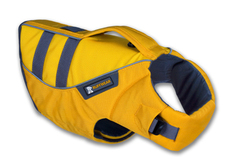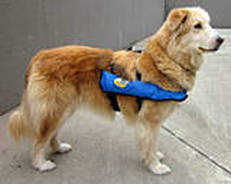Not so long ago the concept of buoyancy aids for dogs was unheard of but nowadays there is a bewilderingly wide range of styles, colours, prices and effectiveness available ... WHY?
There are a very few dogs which, in my opinion should ever be put in a buoyancy aid ... and these ARE buoyancy aids we’re talking about here, NOT LIFEJACKETS; I have never come across a lifejacket for a dog yet (please do tell me if you have!)
A couple of definitions first
LIFEJACKET – “a sleeveless jacket of buoyant or inflatable construction, for supporting the wearer in deep water and preventing drowning” “A life preserver in the form of a sleeveless jacket or vest”
BUOYANCY AID – “a sleeveless jacket lined with buoyant material, worn for water sports” “personal flotation device”
i.e. a life jacket, because of its design and construction will save your life if you become unconscious in the water (providing you don’t die of hypothermia of course!!) by maintaining you in a position such that your face is out of the water by means of a large inflated stand-up collar. A buoyancy aid is merely that, an AID to buoyancy ... it will not save you life if you become unconscious.
When might a dog owner be advised to put his or her dog in a buoyancy aid?
1. If the dog lives or is travelling on a boat : Many people live or holiday on boats of all types these days and IF there is a danger that the dog may fall, or jump, overboard, especially from a fast-moving boat, then a buoyancy aid with a “grab handle” can be useful for getting the dog back on board and give it support, maybe in a rough sea, while the boat comes about which might take a little time and if a longer time, will mean the dog gets tired less quickly due to its added buoyancy.
2. If the dog has a medical problem e.g. recovering from accident or surgery, limb paralysis etc
3. As a TEMPORARY measure to improve potentially dangerous swimming style (see previous post about dog collars for fuller explanation)
The first two above are self-explanatory. The third is maybe more contentious.
Over many years I have been involved with training working Newfoundlands in water-rescue skills. Very occasionally I have come across a dog with the poor swimming style referred to in my earlier post (see post on dog collars), This can be as a result of inexperience – a young dog not used to controlling its increasing mass in water (Newfs can put on about a stone in weight per month in their peak growing phase) or, more likely a laid-back “lazy” dog who hardly uses its back legs and depends on the power from the shoulders. As a dog that is a draught dog on land as well as a “puller” in water, the shoulder power is dominant. (rather like some of the Australian Olympic swimmers of the 60s? 70s?) Provided the shoulder power is greater than the leg lift, a strong, angled swimming position can be adopted, but if there is insufficient power in the shoulders (as for example in a younger dog) the position would pass the critical point and the dog approaches the vertical with possibly disastrous consequences. A buoyancy aid, by enforcing a near-horizontal position in the water will raise the back end and encourage great use of rear legs. Once this has become a habit the B.A. should be dispensed with!!
The wearing of a B.A. when not “essential” will prevent the building of strength and stamina and in a working gundog for example would be far more dangerous even than wearing a collar!! Waterfowlers’ dogs sometimes wear close-fitting neoprene vests, but these are mainly for warmth although anyone who has tried to swim “properly” in a steamer wetsuit will know that is really difficult as they affect balance and give quite a degree of added buoyancy as well.
If you really must (for one of the above good reasons!) put your dog in a buoyancy aid . . . .
. . . . GET A GOOD ONE THAT FITS YOUR DOG PROPERLY.
There are a very few dogs which, in my opinion should ever be put in a buoyancy aid ... and these ARE buoyancy aids we’re talking about here, NOT LIFEJACKETS; I have never come across a lifejacket for a dog yet (please do tell me if you have!)
A couple of definitions first
LIFEJACKET – “a sleeveless jacket of buoyant or inflatable construction, for supporting the wearer in deep water and preventing drowning” “A life preserver in the form of a sleeveless jacket or vest”
BUOYANCY AID – “a sleeveless jacket lined with buoyant material, worn for water sports” “personal flotation device”
i.e. a life jacket, because of its design and construction will save your life if you become unconscious in the water (providing you don’t die of hypothermia of course!!) by maintaining you in a position such that your face is out of the water by means of a large inflated stand-up collar. A buoyancy aid is merely that, an AID to buoyancy ... it will not save you life if you become unconscious.
When might a dog owner be advised to put his or her dog in a buoyancy aid?
1. If the dog lives or is travelling on a boat : Many people live or holiday on boats of all types these days and IF there is a danger that the dog may fall, or jump, overboard, especially from a fast-moving boat, then a buoyancy aid with a “grab handle” can be useful for getting the dog back on board and give it support, maybe in a rough sea, while the boat comes about which might take a little time and if a longer time, will mean the dog gets tired less quickly due to its added buoyancy.
2. If the dog has a medical problem e.g. recovering from accident or surgery, limb paralysis etc
3. As a TEMPORARY measure to improve potentially dangerous swimming style (see previous post about dog collars for fuller explanation)
The first two above are self-explanatory. The third is maybe more contentious.
Over many years I have been involved with training working Newfoundlands in water-rescue skills. Very occasionally I have come across a dog with the poor swimming style referred to in my earlier post (see post on dog collars), This can be as a result of inexperience – a young dog not used to controlling its increasing mass in water (Newfs can put on about a stone in weight per month in their peak growing phase) or, more likely a laid-back “lazy” dog who hardly uses its back legs and depends on the power from the shoulders. As a dog that is a draught dog on land as well as a “puller” in water, the shoulder power is dominant. (rather like some of the Australian Olympic swimmers of the 60s? 70s?) Provided the shoulder power is greater than the leg lift, a strong, angled swimming position can be adopted, but if there is insufficient power in the shoulders (as for example in a younger dog) the position would pass the critical point and the dog approaches the vertical with possibly disastrous consequences. A buoyancy aid, by enforcing a near-horizontal position in the water will raise the back end and encourage great use of rear legs. Once this has become a habit the B.A. should be dispensed with!!
The wearing of a B.A. when not “essential” will prevent the building of strength and stamina and in a working gundog for example would be far more dangerous even than wearing a collar!! Waterfowlers’ dogs sometimes wear close-fitting neoprene vests, but these are mainly for warmth although anyone who has tried to swim “properly” in a steamer wetsuit will know that is really difficult as they affect balance and give quite a degree of added buoyancy as well.
If you really must (for one of the above good reasons!) put your dog in a buoyancy aid . . . .
. . . . GET A GOOD ONE THAT FITS YOUR DOG PROPERLY.
Some of the models available are ill-fitting and nothing more that some foam wrapped in nylon with a couple of straps to hold them in vaguely the right position albeit sliding around somewhat ... and even those ones are not cheap! For boat owners it is possible, in the U.S., to buy a self-inflating model, akin to the ones that humans wear, that inflates as soon as it hits the water, but I can’t in all honesty see the point of those for a dog, not least because every time it inflates, a new “gas” cartridge has to be bought and fitted. If you have a dog that likes jumping overboard that could be a costly nightmare! In addition, even in an emergency, this type goes off with quite a “bang” (I’ve seen them in action on humans) and would be an additional scare for the dog if it had fallen in accidentally and was already somewhat stressed!!
So why the “fashion” for so many dogs to wear a buoyancy aid? (remember, it is NOT a life jacket) . . . . I have no idea!
If anyone can enlighten me, please do so!!
Lastly, I have no idea how retailers and manufactures of these items are allowed to advertise them as lifejackets . . . if they were doing so for the human equivalent, they’d soon be under the scrutiny of the Advertising Standards Authority (in the UK) !!
If anyone can enlighten me, please do so!!
Lastly, I have no idea how retailers and manufactures of these items are allowed to advertise them as lifejackets . . . if they were doing so for the human equivalent, they’d soon be under the scrutiny of the Advertising Standards Authority (in the UK) !!


 RSS Feed
RSS Feed
